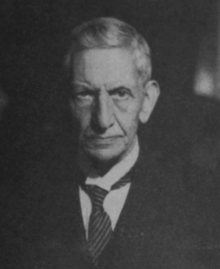Ebrahim Hakimi
| Ebrahim Hakimi | |
|---|---|
 | |
| 29th Prime Minister of Iran | |
|
In office 29 December 1947 – 13 June 1948 | |
| Monarch | Mohammad Reza Pahlavi |
| Preceded by | Mohammad-Reza Hekmat |
| Succeeded by | Abdolhossein Hazhir |
|
In office 30 October 1945 – 28 January 1946 | |
| Monarch | Mohammad Reza Pahlavi |
| Preceded by | Mohsen Sadr |
| Succeeded by | Ahmad Qavam |
|
In office 13 May 1945 – 6 June 1945 | |
| Monarch | Mohammad Reza Pahlavi |
| Preceded by | Morteza-Qoli Bayat |
| Succeeded by | Mohsen Sadr |
| President of Senate | |
|
In office 19 August 1951 – 1 March 1957 | |
| Preceded by | None |
| Succeeded by | Hasan Taqizadeh |
| Personal details | |
| Born |
15 August 1871 Tabriz, Iran |
| Died |
19 October 1959 (aged 88) Tehran, Iran |
| Political party |
Revival Party (1920s)[1] Democrat Party (1910s)[1] |
| Alma mater | Paris University |
Ebrahim Hakimi (15 August 1871 – 19 October 1959) was an Iranian statesman, who served as prime minister of Iran on three occasions.
Early life and education
Born in Tabriz, Ḥakimi was part of "an old and prominent family of court physicians", who traced their status as far back as the 17th century, "starting with the eponym of the family, Moḥammad-Dāvud Khan Ḥakim" who served at the courts of the Safavid kings (shahs) Safi (r. 1629-1642) and Abbas II (r. 1642-1666).[2] This ancestor of Ebrahim was also the founder of the Hakim Mosque located in Isfahan.[2]
After finishing elementary and high school in Tabriz, Hakimi attended Dar ol-Fonoon in Tehran, and finished advanced studies in Medicine in Paris.
Career
Hakimi served as royal physician to Mozzafar-al-Din Shah. He then became a member of the Parliament, and served as cabinet minister 17 times, as prime minister for three terms, and as speaker of the Senate of Iran.
His second tenure as prime minister was short-lived (three months) as the Soviets, angry over his refusal to grant them an oil concession in Northern Iran, inspired Azerbaijani Communists to declare independence from Iran. Soviet troops occupying the Northern regions refused to allow Iranian troops to enter the region to put down the uprising. Hakimi submitted the issue to the UN Security Council and resigned from office as a protest of Soviet actions in January 1946.[3]
Death
Hakimi died in Tehran at the age of 88.
See also
References
- 1 2 Abrahamian, Ervand (1982). Iran Between Two Revolutions. Princeton University Press. p. 123. ISBN 0-691-10134-5.
- 1 2 Milani 2003, pp. 575-580.
- ↑ "Iran Premier Resigns after 3-Month Term". Herald Journal. Tehran. UP. 21 January 1946. Retrieved 11 November 2012.
Sources
- Milani, Abbas (2003). "ḤAKIMI, EBRĀHIM". Encyclopaedia Iranica, Vol. XI, Fasc. 6. pp. 575–580.
- 'Alí Rizā Awsatí (عليرضا اوسطى), Iran in the Past Three Centuries (Irān dar Se Qarn-e Goz̲ashteh - ايران در سه قرن گذشته), Volumes 1 and 2 (Paktāb Publishing - انتشارات پاکتاب, Tehran, Iran, 2003). ISBN 964-93406-6-1 (Vol. 1), ISBN 964-93406-5-3 (Vol. 2).
| Political offices | ||
|---|---|---|
| Preceded by Morteza-Qoli Bayat |
Prime Minister of Iran 1945 |
Succeeded by Mohsen Sadr |
| Preceded by Mohsen Sadr |
Prime Minister of Iran 1945–1946 |
Succeeded by Ahmad Qavam |
| Preceded by Mohammad-Reza Hekmat |
Prime Minister of Iran 1947–1948 |
Succeeded by Abdolhossein Hazhir |
| New title | President of Senate 1951–1957 |
Succeeded by Hasan Taqizadeh |